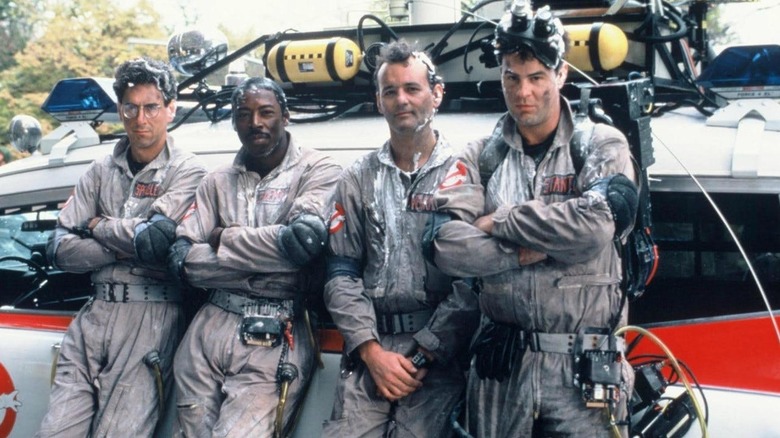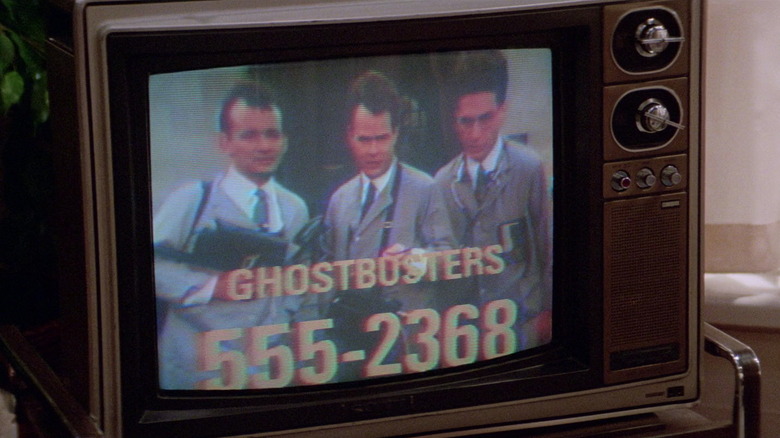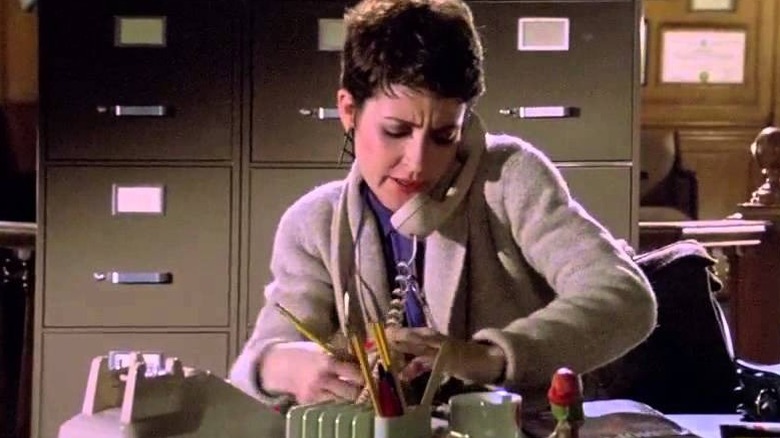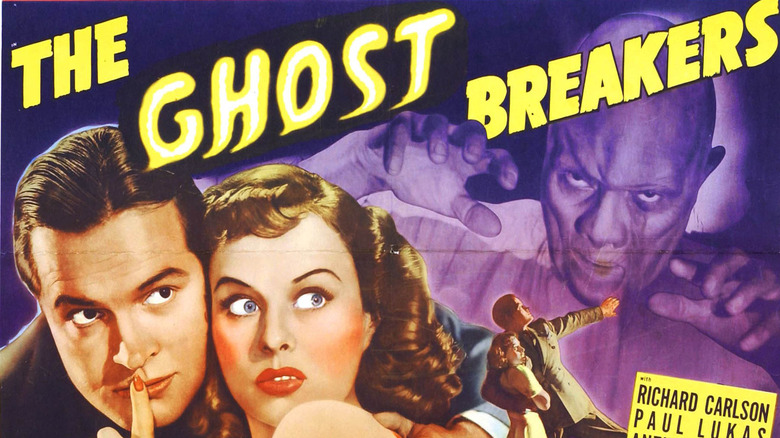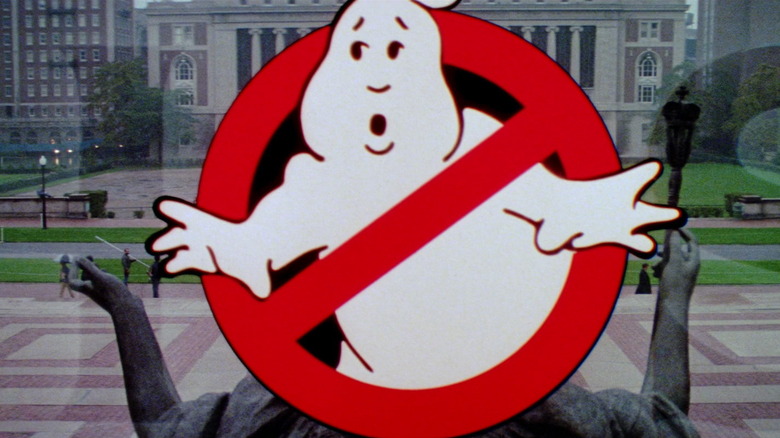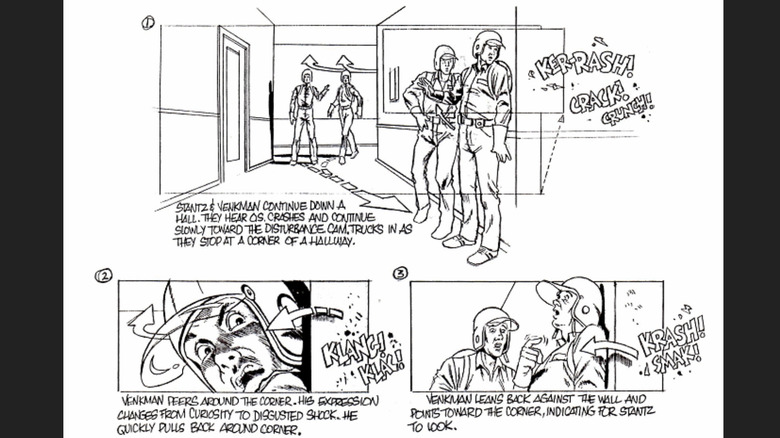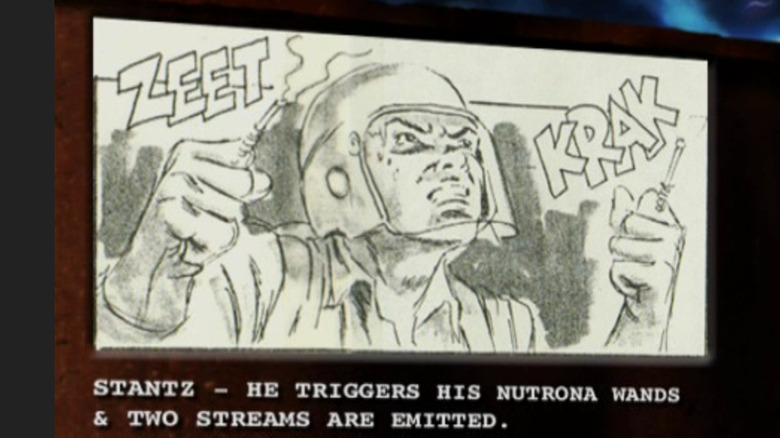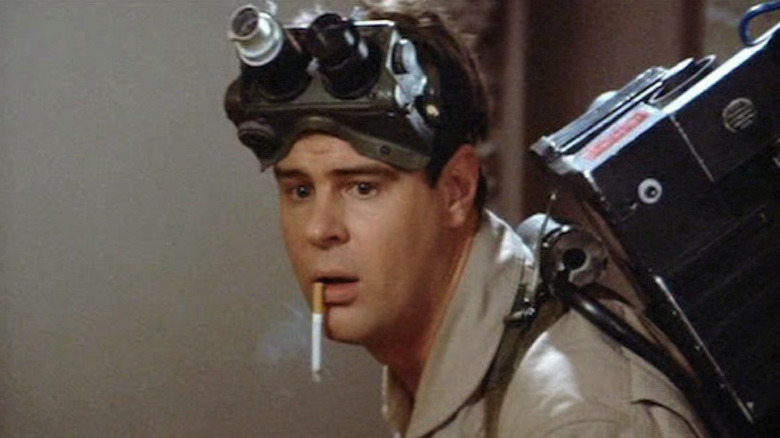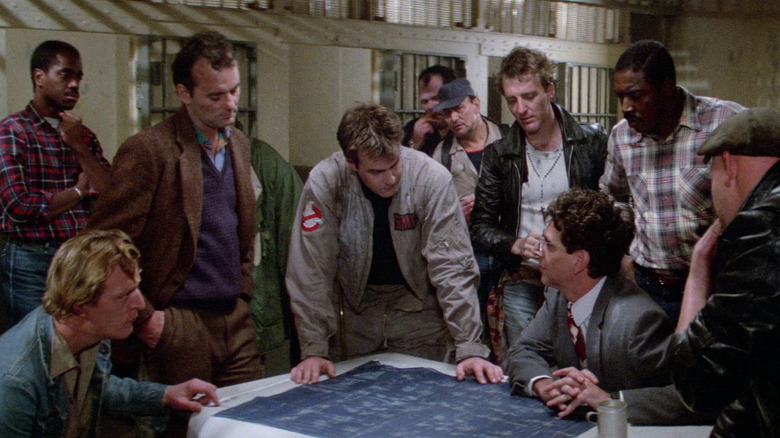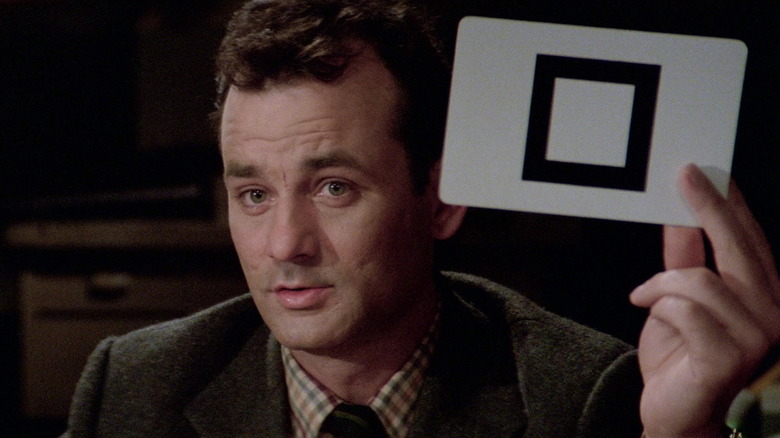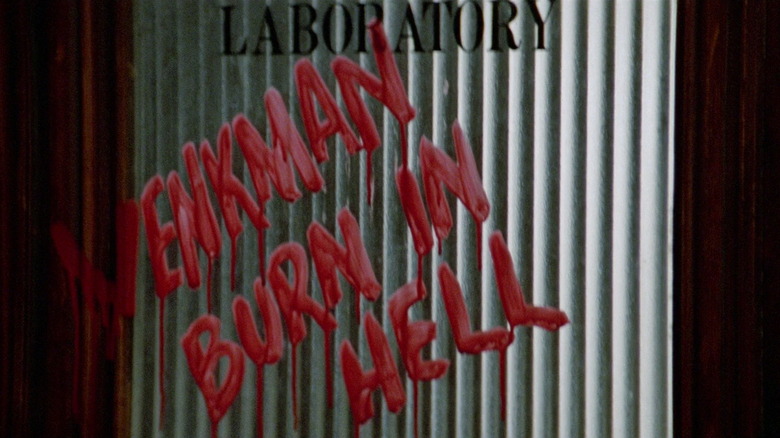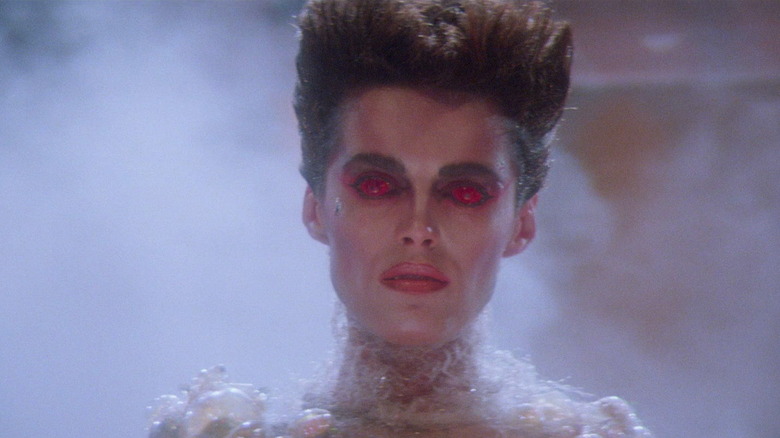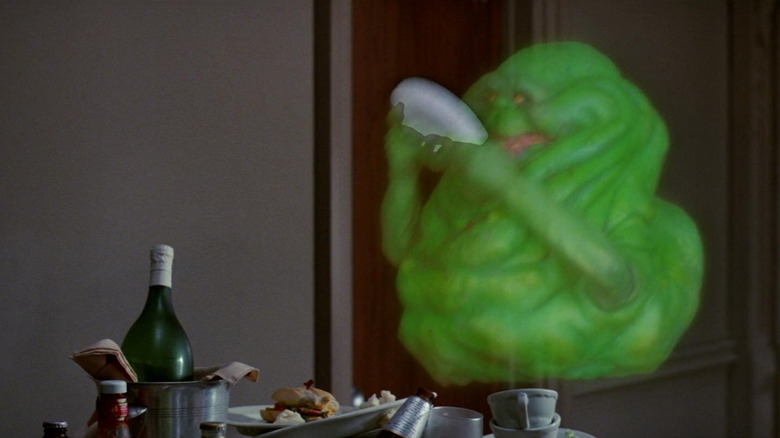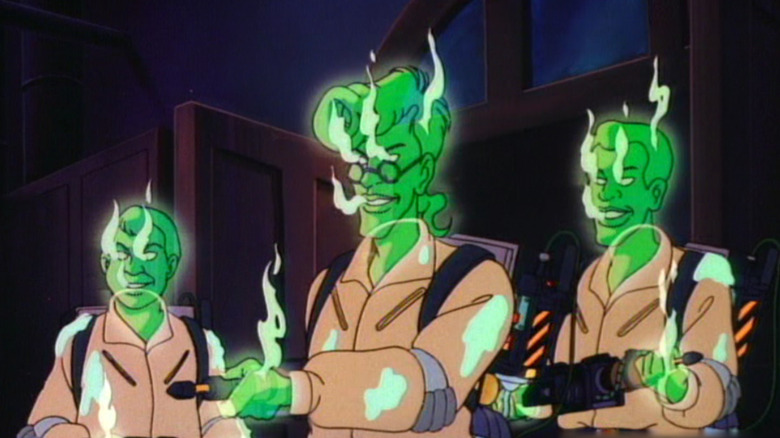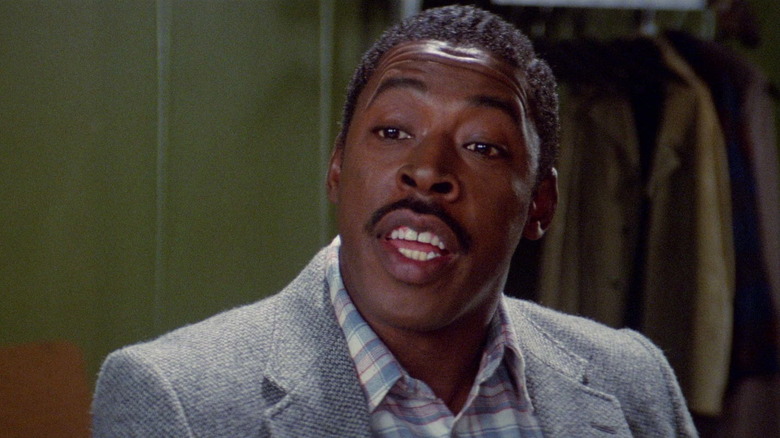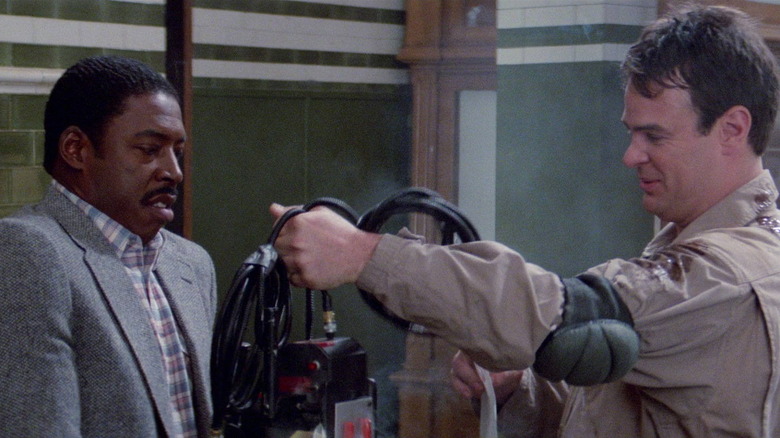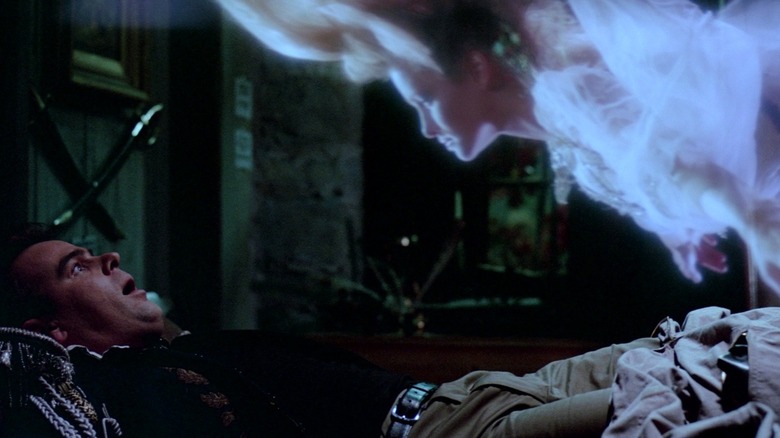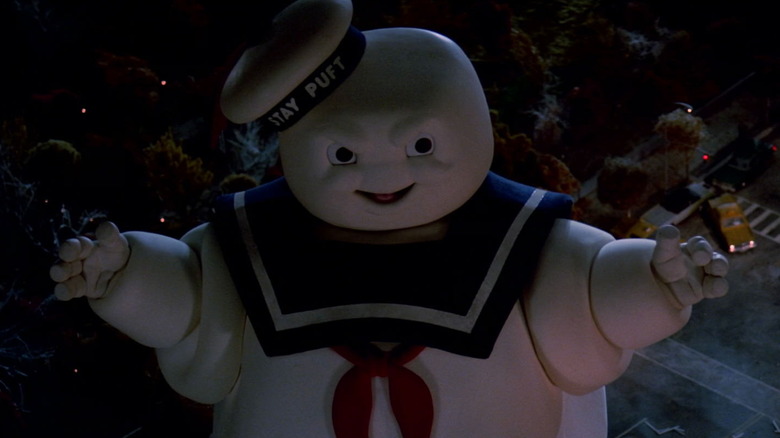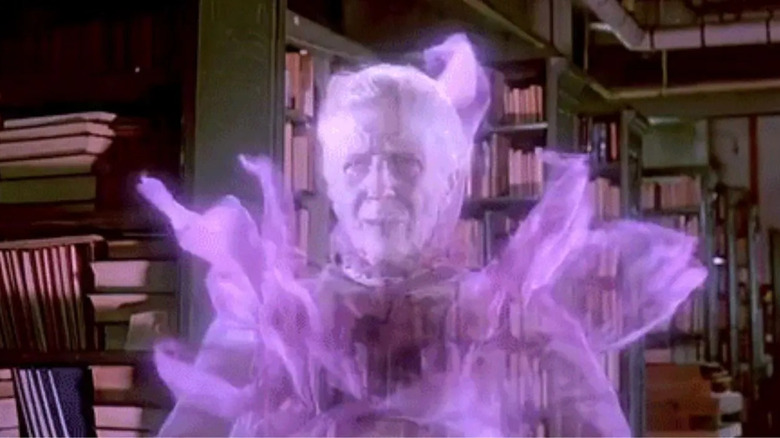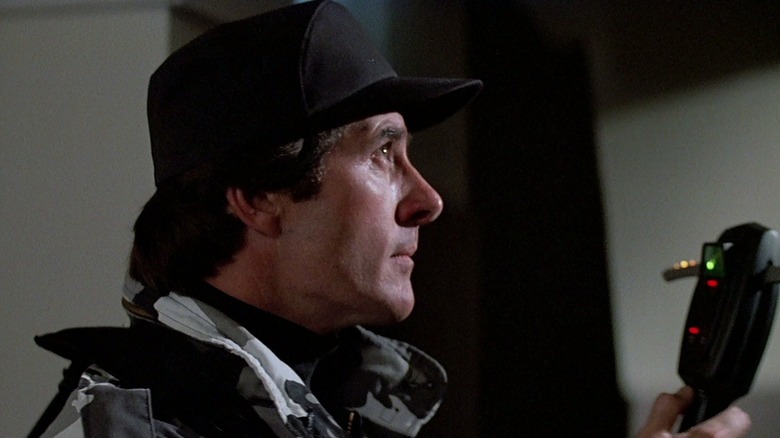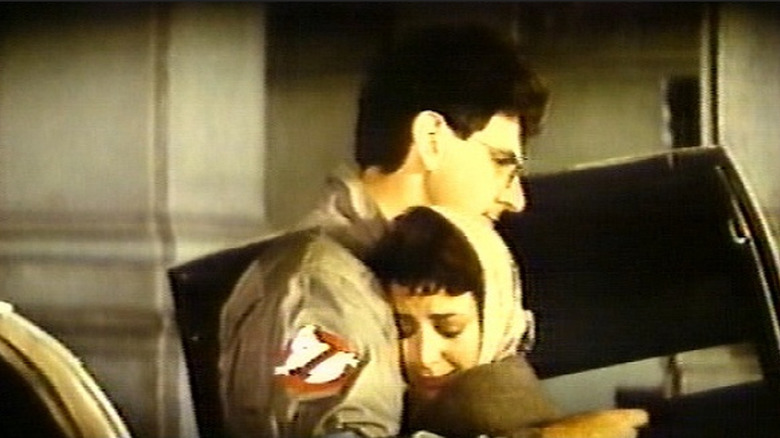20 Things You Didn't Know About Ghostbusters
The first "Ghostbusters" film opened on June 8, 1984, and went on to make close to $300 million on a roughly $30 million budget.
It notched top-grossing film status for eight weeks, and the second-highest-grossing rank for six weeks, before returning to the box office top 10 for its two-week re-release in August of 1985.
Not only did "Ghostbusters" beat both "Indiana Jones and the Temple of Doom" and "Gremlins" for the highest-grossing films that debuted in 1984, but it jockeyed for first place with "Beverly Hills Cop" before surpassing it in 1985, and also surpassed 1978's "National Lampoon's Animal House" as the highest-grossing comedy film in history, until 1990's "Home Alone."
"Ghostbusters" was nominated for two Academy Awards in 1985 — best original song for "Ghostbusters" by Ray Parker Jr., which lost to Stevie Wonder's "I Just Called to Say I Love You" from "The Woman in Red," and best visual effects, which it lost to "Indiana Jones and the Temple of Doom" — and in 2001, the American Film Institute ranked "Ghostbusters" 28th on its "100 Years...100 Laughs" list of best comedy films.
What follows are more facts you might not know about 1984's "Ghostbusters," plus related information touching on its three follow-up films, two-and-a-half animated spin-off series, and multiple tie-in comic books and video games.
Who You Gonna Call?
To promote the 1984 film, the Ghostbusters' TV commercial was re-edited for a trailer that replaced its phony 555-2368 phone number with the then-operational 1-800-654-1984, which received an estimated 1,000 calls per hour, around the clock, for six weeks.
Callers heard a pre-recorded dialogue by Dan Aykroyd and Bill Murray, using their real names, but still basically in-character from the film, claiming they were out investigating "a possible infestation backstage at the show 'La Femme Des Paris' at the Waverly Theater in Times Square," for which they were "bringing all of our equipment into the girls' dressing room" for "a complete sweep" that "could take a couple of weeks."
Aykroyd and Murray elaborated on the need to follow up with "Brigitte" and "Fifi" personally, before encouraging callers to "go see the Ghostbusters movie."
In September of 2014, Sony created another temporary phone number (212-897-1964, with a New York City area code) for the 1984 film's 30th anniversary and Blu-ray release.
This time, callers heard a pre-recorded message from Annie Potts as Janine Melnitz, complaining, "I've been working here for 30 years and I still get no respect. I've quit better jobs than this," before adding, "I stay because I love it. We couldn't have gotten where we are today without all of you, so thanks for your support along the way."
"Janine" then encouraged fans to visit the Ghostbusters website and "remember to always be humanitarian like Egon, even if they're not human."
Who You're NOT Gonna Call
As documented by Getty Images photographer Trevor James Robert Dallen on Dec. 19, 1984, the first Ghostbusters film's hotline haunted an Australian woman — Mary Walton of Hurlstone Park, a suburb of Sydney — whose phone number was similar enough for her to receive calls from children "wanting ghosts busted."
Fellow Australian Chris Hemsworth, as Kevin Beckman from 2016's "Ghostbusters: Answer the Call," was more receptive to such calls, via that year's UK promotional phone number of 0800 2229 911, whose pre-recorded message apologized for not answering calls "due to the considerable rise in paranormal activity."
"Kevin" directed fans to the 2016 film's Facebook page, after advising them, "If you've experienced strange noises or feelings of dread, just ignore them and hope they go away. If you're troubled by a floating apparition, open a window and turn on a fan. Anything worse, run! And leave the Ghostbusting to us."
Ghost...Breakers?
Well into shooting the 1984 original, the folks making the film didn't know who they were gonna call, because Filmation (home of "He-Man and the Masters of the Universe") had made a live-action children's sitcom called "The Ghost Busters" for CBS in 1975.
Alternate titles under consideration included "Ghostsmashers," "Ghoststoppers," "Ghostblasters" and "Ghostbreakers" (itself the title of a 1940 Bob Hope comedy film), but the folks making what would become "Ghostbusters" held out hope of securing the rights to that title from Universal Pictures, enough that they filmed certain scenes more than once, including exterior shots of the firehouse with banners bearing those alternate titles.
Joe Medjuck, one of the film's associate producers, put a stop to this practice by calling Columbia Pictures from a payphone at the filming of the Ghostbusters' arrival at Central Park West to save the day. He told the studio to listen to the hundreds of extras who were chanting "Ghostbusters" over and over, and pointed out how unfeasible it would be to try and shoot such scenes repeatedly.
Fortunately, Columbia Pictures President Frank Price — who'd greenlit the film based on the premise Aykroyd summed up as "Ghost Janitors in New York" — became chairman of the MCA Motion Picture Group in November of 1983, which granted him control over Universal Pictures.
Price sold Columbia the "Ghostbusters" title for $500,000 plus 1% of the film's profits, and thanks to "Hollywood accounting," the film technically never made a profit from which Universal could be owed.
The No-Ghost Is Named Mooglie
Before the Ghostbusters could claim their name, they already had a brand, in the form of a white ghost trapped by the bar of a red "no" circle.
Dan Aykroyd's script described the concept, but the "no-ghost" logo was designed by Michael C. Gross, another associate producer and art director for the film, who worked with creature design consultant Brent Boates to render the image.
Gross also served as art director for National Lampoon magazine from 1970-74, creating the "If You Don't Buy This Magazine, We'll Kill This Dog" cover for its January 1973 "Death" issue, before becoming the personal art designer for John Lennon and an art consultant to the Muppets. "Ghostbusters" and "Ghostbusters II" were among the 15 TV and movie projects on which Gross was listed as a producer from 1978-94, before he died of cancer at the age of 70 in 2015.
Gross' iconic ghost gained a life of its own, as Ivan Reitman revealed to HitFix that he and Aykroyd nicknamed it "Mooglie" — a nickname repeated by Ray Stantz in the Ghostbusters comics by IDW Publishing — and the intros and bumpers for "The Real Ghostbusters" cartoon depicted Mooglie as its own character.
The cartoon's 1987 episode "The Copycat" showed the titular metamorph mimicking the "no-ghost" symbol, while 2016's "Ghostbusters: Answer the Call" elevated the iconic ghost to the team's archenemy, a mad scientist and occultist named Rowan North (played by Neil Casey), who kills himself to become a powerful spirit.
Reitman Called Aykroyd's Script A Phone Book
Before the 1984 film even had a logo or a settled title, "Ghostbusters" director Ivan Reitman had to recruit Harold Ramis to help him channel Dan Aykroyd's vision into a filmable script.
According to Reitman's "domino theory of reality," a film that starts with a solid grounding in the ordinary can ultimately persuade audiences to accept absurdities even as large as a 100-plus-foot-tall Stay-Puft Marshmallow Man. This made Reitman an ideal director to winnow down a script whose size he compared to a "phone book," since he recalled its first draft as about 70-80 pages long, before it ballooned to 180 pages by the time it was handed to Richard Edlund, who headed up the film's visual effects.
In 1981, Aykroyd began writing "Ghost Smashers" (the script's original title) to star himself as Stantz, his fellow Blues Brother John Belushi as Venkman, and his eventual 1983 "Trading Places" costar Eddie Murphy as "Ramsey."
And that's the simple part, since instead of being set in New York City during the contemporary present of the 1980s, the "Ghost Smashers" script opened in the then-future year of 2012, by which time Ghostbusters had become as commonplace and necessary as a combination of pest control, sanitation workers and first responders.
Aykroyd imagined Ghostbusting becoming such an established business model that multiple competitive franchises of spirit-trappers would operate around the world, because he believed such aspects of the supernatural would be scientifically proven true in the future.
Ghost Smashers Wielded Wands, Not Proton Blasters
No, not wizards' wands, but in place of the hand-held Proton Blasters that appeared in the film, each Ghost Smasher's Proton Pack fed power to twin adjustable-length antennae identified in storyboards as "Nutrona" (not "Neutrona") Wands, one for each arm, mounted to their wrists and extendable from their palms.
The Ghost Smashers' uniforms were scripted practically, as both janitorial and tactical, with law enforcement riot control gear including helmets with transparent face-shields, even as Aykroyd's fantastical script sent the team traveling through time and space, with a dematerializing Ectomobile, and a culmination that whisked our haunt-stopping trio into alternate dimensions.
This all followed a prologue stating that a hole had already been torn in our reality, that allowed entities from the other side to enter our world.
Just as other Ghostbusters had government, corporate or private sponsors, the Ghost Smashers were employed by the wealthy, eccentric Ivo Shandor, while Mr. Stay-Puft first appeared well before the story's climax, as one of many forms adopted by Gozer.
The Ghost Smashers' Containment Unit was kept at a deserted Sunoco gas station in northern New Jersey, with a viewer that allowed them to look inside, which was nixed for the film, but made it into both 1984's "Ghostbusters: The Novel" by Larry Milne and "The Real Ghostbusters" cartoon.
The ghosts' release yielded an explosion of paranormal energy that triggered a 25-acre sinkhole around the gas station, disrupting a long-dormant fault line that destroyed northern New Jersey.
Aykroyd Comes From A Family Of Real-Life Spirit-Seekers
Ivan Reitman told Esquire "Ghost Smashers" would have cost around $200 million to produce, after he'd pledged Columbia Pictures President Frank Price a ballpark budget of $30 million.
Fortunately, Aykroyd understood the need to scale down his ambitions, since he told Vanity Fair he's "a kitchen-sink writer" who throws "everything in" and relies on collaborators to "bring it into reality," and also because he had literal generations of knowledge on the script's subject.
Dan's great-grandfather, Dr. Samuel Augustus Aykroyd, conducted seances in the same family farmhouse where Dan grew up and still lives, during the spiritualist craze of the 19th century.
Dan's grandfather, Maurice James Gladstone Aykroyd, was an engineer for the Bell Telephone Company of Canada, who not only constructed a crystal radio to communicate with spirits, but also invited ghosts into the family's home while Dan was growing up.
Dan's father, Samuel Cuthbert Peter Hugh Aykroyd, maintained an extensive library on spirits, the supernatural and paranormal phenomena until his death at the age of 98 in 2020, and in 2009, he co-authored "A History of Ghosts: The True Story of Séances, Mediums, Ghosts, and Ghostbusters."
Even Dan's mother, Lorraine Gougeon Aykroyd, claimed she'd seen apparitions of his great-great-grandparents while nursing him.
And in 1981, Dan read an article on quantum physics and parapsychology, in The Journal of the American Society for Psychical Research, that sparked his desire to update decades-old ghost comedy films like Bob Hope's "The Ghost Breakers."
Aykroyd's Eerie Experiences Extend Beyond His Haunted Homes
Although Aykroyd hasn't noticed any stray spirits at his family homestead since he reached adulthood, he claims to have encountered the ghost of "Mama Cass" Elliot, of The Mamas & the Papas, during her alleged hauntings of his former bungalow in Los Angeles.
And when the 1984 film shot the scene of the Ghostbusters in jail, in an actual New York prison facility that had been decommissioned and essentially abandoned, Aykroyd echoed those who suggested the location was haunted, a suspicion which was fed by the unexplained appearance of scratches all over the dailies that were shot there. Film editor Sheldon Kahn was able to work around the scratches on the footage, enough that a reshoot of the jail scene wasn't necessary, much to the relief of Ivan Reitman, who hoped never to return to that location.
In the film's DVD commentary track, Harold Ramis placed the prison's location as somewhere in the middle of 14th Street, not Lower Manhattan, while Reitman confirmed it was a police station. Without confirming the exact location, the inlay booklet of the 2014 Ghostbusters 1&2 Gift Set, on page 3 of "The Story of Ghostbusters," mentions one of the shooting locations as "the old New York Police Department lock-up."
Aykroyd has professed otherworldly close encounters of the alien kind, as well. In 2005, he released the documentary "Dan Aykroyd Unplugged on UFOs," which includes interviews, footage of supposed extraterrestrial sightings, and his own personal accounts.
Much Of The Film's 'Science' Is Real(ish)
The 1984 film's most infamous experiment is a combination of two actual experiments, both of which have been heavily criticized by real-world scientists.
The cards whose symbols Venkman asks the two students to identify, without seeing them, were designed by perceptual psychologist Karl Zener during the 1930s, for experiments conducted at Duke University with his colleague, Joseph Banks Rhine, to test for extrasensory perception.
The term "parapsychology" was coined in 1889 by philosopher Max Dessoir as the German "parapsychologie," but it was popularized by J.B. Rhine, in his 1937 book "New Frontiers of the Mind," as a replacement for the term "psychical research." Rhine founded both parapsychology as a branch of psychology and the autonomous parapsychology laboratory within Duke University.
Karl Zener requested they no longer be called "Zener cards" after Rhine's experiments with them were discredited by their peers, due to a combination of "sensory leakage" and cheating.
The electric shocks Venkman administers to the male student, purportedly to study the effect of "negative reinforcement" (actually positive punishment) on ESP ability, were inspired by Yale University psychologist Stanley Milgram's experiments, which began in 1961, and whose findings were presented in his 1974 book "Obedience to Authority: An Experimental View."
Milgram measured the willingness of study participants to obey authority figures ordering them to perform acts that conflicted with their consciences, specifically administering fake electric shocks (which they believed were real) to people who pretended to feel pain.
The Film's Experiment Tested Its Audiences' Sympathies
While Milgram's experiment obviously raised a number of ethical concerns, Harold Ramis jokingly suggested this scene had Venkman unrepentantly employ Milgram's methodology to test audiences' willingness to accept an ostensible "hero" who would unfairly administer painful but non-lethal electric shocks to others.
The experiment was one of Bill Murray's favorite scenes during the filming of "Ghostbusters," and his visible enthusiasm makes sense of the graffiti on his office door — "Venkman Burn in Hell" — paraphrasing the similar graffiti of "Carrie White Burns in Hell!" from 1976's "Carrie."
The door's graffiti originally rhymed with "Venkman Darns Socks in Hell," itself paraphrasing one of Linda Blair's least G-rated quotes from 1973's "The Exorcist," but Reitman wanted to keep the film relatively family-friendly.
Columbia University agreed to lend the film an academic verisimilitude, by having its real-life Havemeyer Hall provide the shooting interiors for the fictional "Weaver Hall," home of the equally nonexistent Paranormal Studies Laboratory (in Room 205 A) occupied by Drs. Spengler, Stantz and Venkman.
However, given the film's ethically dubious characterization of a field of research already regarded as suspect by most reputable real-world scientists, the university stipulated that Columbia itself should not be identified by name onscreen.
Adding a touch of technological verisimilitude was an Apple II knockoff, the Franklin Ace 1000, in the Ghostbusters' firehouse, used to simulate Kirlian photography by capturing the image of Vinz Clortho, Keymaster of Gozer, in his Terror Dog form, inside the possessed Louis Tully's body.
Gozer Was A Gestalt
In both real-life casting and storytelling inspirations, the Ghostbusters' supernatural adversary Gozer was assembled from multiple sources.
On the 2009 "Ghostbusters: Slimer Mode" Blu-ray, film historian Paul M. Sammon recounted how Gozer almost manifested as Ivo Shandor, planned to be played by Paul "Pee-wee Herman" Reubens, and according to page 170 of Don Shay's 1985 "Making Ghostbusters," Aykroyd and Ramis' script drafts envisioned Gozer as resembling first Bert Parks, then Robert Young, before director Ivan Reitman suggested an androgynous figure.
Shay quoted associate producer Joe Medjuck in naming musicians David Bowie and Grace Jones as two inspirations, before Yugoslavian model Slavitza Jovan was cast to embody Gozer.
British-American actress Paddi Edwards — who performed voiceover roles for Disney's "The Little Mermaid" and "Hercules," and appeared onscreen in "Star Trek: The Next Generation" — supplied Gozer's voice, after Bill Murray mocked Jovan's thick Slavic accent, according to page 183 of Shay's "Making Ghostbusters."
On the 2005 "Ghostbusters" DVD commentary track, Ramis recalled "punk rock singer" Anne Carlisle, star of 1982's "Liquid Sky," declining the role of Gozer, although she would appear in 1986's "Crocodile Dundee" as the trans woman character Gwendoline.
On page 97 of "Making Ghostbusters," Shay quoted Aykroyd as attributing Gozer's inspiration to both a Gozer Chevrolet dealership in upstate New York and documented reports of a council house in Enfield, London, being haunted between 1977-79, during which one medium claimed to have contacted a spirit called Gozer, whom she described as "a nasty piece of work."
John Belushi's Spirit Haunted Ghostbusters, Onscreen And Off
Belushi's death on March 5, 1982, meant recasting the role of Peter Venkman, which Aykroyd had written for him, but Aykroyd and Ramis still managed to work him into "Ghostbusters."
Like Ivo Shandor and Gozer, what started as the "Onionhead" ghost — so dubbed due to the stench it was originally written as emitting, according to page 64 of Don Shay's "Making Ghostbusters" — persisted in various forms from the earliest drafts of the film's script.
But it wasn't until Ivan Reitman remarked upon the resemblance of "Onionhead" to Belushi as Bluto in "National Lampoon's Animal House" (Shay, page 78) that Steve Johnson, the visual effects crewmember who sculpted both the librarian ghost and the "Onionhead" ghost that became known as "Slimer," received Aykroyd and Ramis' request to redesign Slimer in Belushi's likeness, less than 24 hours before Johnson's deadline.
Johnson told Bloody Disgusting, "I pulled out a stack of headshots of John Belushi, poured a gram of cocaine on it and started chopping lines up," when the literal ghost of Belushi himself allegedly manifested to model for him, so Johnson could get his likeness just right for Slimer, before Belushi departed with the warning, "Watch that (stuff) Steve, it'll kill you."
Slimer compounded visual effects crewmembers' headaches when his miniature figure, made to fly around the Sedgewick Hotel's chandelier, proved too big, so as creature design consultant Terry Windell said on the 1999 "Ghostbusters" DVD, "We basically spray-painted a peanut green."
Slimer Connected The Film To The Cartoon
On the 2005 "Ghostbusters" DVD commentary track, Ivan Reitman admitted to voicing both Slimer and Zuul in the 1984 film, while Frank Welker voiced Slimer in "The Real Ghostbusters" cartoon from 1986-91.
The cartoon first named the former "Onionhead" ghost "Slimer," and explicitly referenced specifics from the film in episodes 10 and 11 of its first season, written by future "Babylon 5" creator J. Michael Straczynski.
In "Take Two," the Ghostbusters oversee production of a movie about them, and cartoon Peter Venkman metafictionally complains that live-action Bill Murray "doesn't look a thing like me."
And "Citizen Ghost" depicted the aftermath of the team's battle with Gozer, as they rebuilt their firehouse and Containment Unit, and their original uniforms manifested "spectral" duplicates of their former wearers, due to how much psychokinetic energy they'd absorbed.
The team adopted Slimer after he helped defeat their doppelgangers.
Winston Ramsey Zeddemore Nearly Stole The Show
As Ernie Hudson told The A.V. Club, he was the only actor from the 1984 film who auditioned to voice his character in the cartoon, but he lost the role to Arsenio Hall.
And as Eddie Murphy told Jimmy Fallon, he was unavailable to play "Ramsey" in what would become "Ghostbusters" because he needed to work on "Beverly Hills Cop."
As "Ramsey" became Winston Zeddemore, future "Die Hard" and "Family Matters" star Reginald VelJohnson nearly nabbed the part. Hudson won their competing final auditions, but Ivan Reitman cast VelJohnson as the prison guard in the jail scene to thank him for his trouble.
On page 29 of Aykroyd and Ramis' August 5, 1983, draft of the script, Winston introduced himself to Ray Stantz as a five-year veteran of the Air Force's Air Police (now Security Forces), who made captain and administered perimeter security at Reese Strategic Air Command Base, before he designed electronic barrier systems for Sentry Alarms as a civilian, and wound up as vice-president of tactics and training at the company's Pacific headquarters.
Winston added he was "a 15th-degree black belt in Wing Chun boxing" and "a qualified, award-winning weapons handler."
Ernie Hudson Got Robbed
The August 5, 1983, script draft also had Winston getting slimed (on page 51) and choosing Gozer's form as the Stay-Puft Marshmallow Man, because "he was on all the packages we used to buy when I was a kid in North Carolina," and "we used to roast Stay-Puft marshmallows on my grandpa's smokehouse fire" (on page 129).
On page 54 of "Making Ghostbusters," Don Shay quoted Harold Ramis saying, "As writers, we'd never done a Black character," so "we bent over backwards to make Winston's character good — and in doing so, we made him the best character in the movie."
When Ramis realized, in his words, "Jesus! He's got all the good lines," the decision was made to give Peter Venkman, whose character Ramis deemed "a little weak" previously, more of Winston's lines, and to delay Winston's introduction within the film.
Tie-in media have treated Winston better, with the 2009 "Ghostbusters: The Video Game" establishing him as a Marine Corps veteran who apparently obtained a Ph.D. after the events of "Ghostbusters II." During an in-game investigation at the Museum of Natural History, Winston says he "practically lived" in the Egypt exhibit while working on his doctorate.
Ray Stantz's Dream Ghost Had Her Own Subplot
In the final cut of the 1984 film's montage of the Ghostbusters on the job, Ray Stantz is shown dreaming about a beautiful floating phantasm performing an adult-rated act on him, but this scene started as part of a call Ray and Winston responded to at the fictional Fort Detmerring, a historic military installation where Ray stakes out the period-furnished Single Officers' Quarters.
While Winston checks the armory, Ray conducts a sweep of the quarters, before donning an officer's uniform, skimming through one of the bedroom's books ("I don't even understand French"), and falling asleep on its bed.
From there, the needle on one of Ray's meters spikes, as light and mist emanate from the wardrobe, and Ray awakens to see his "dream ghost" hovering over him.
When Winston returns to knock on the door of the Single Officers' Quarters and ask Ray if he's alright, Ray responds with a firm "Later, man!"
When this scene appears as a dream during the montage, the "Ghostbusters" theme plays in the background, but the song's vocals cut out as the "dream ghost" unzips Ray's pants, omitting the lyric "Bustin' makes me feel good."
That's One Big Marshmallow
The Stay-Puft Marshmallow Man appears twice in "Ghostbusters," before Gozer manifests as Mr. Stay-Puft; first on a package next to the carton of eggs that pop out and start frying on Dana Barrett's kitchen counter, then on a mural ad painted on a building across from the firehouse.
According to Esquire, Dan Aykroyd told "my old friend, the Viking," to sketch Mr. Stay-Puft as "a cross between the Michelin Tire Man and the Pillsbury Doughboy," topped with "a little sailor hat," but William Atherton, who played EPA inspector Walter Peck, balked at being dumped on so heavily to make the towering marshmallow man's roast seem real.
Atherton refused to have 150 pounds of shaving cream poured on him, to simulate Mr. Stay-Puft's explosion, without testing it on a stuntman first. When "it knocked (the) poor guy down," Atherton estimated it was reduced to 75 pounds.
The Librarian Ghost's Afterlife Extended Beyond The Film
"Swamp Thing" co-creator Bernie Wrightson drew drafts of what became the Terror Dogs, the Temple of Gozer and the librarian ghost, adding a cartoon balloon reading "Quiet!" to the latter, per page 33 of Don Shay's "Making Ghostbusters."
The 2009 video game established the librarian ghost as Eleanor Twitty, former head of the New York Public Library's special collections, who was murdered in the 1920s by her lover, after denying him further access to the rare books in her care, especially the "Gozerian Codex."
And the 2019 "Cleanin' Up the Town: Remembering Ghostbusters" Blu-ray revealed a nearly-completed puppet for a second stage to the librarian ghost's transformation was nixed by visual effects entrepreneur Richard Edlund due to budgetary concerns, only to be repurposed for 1985's "Fright Night," another Columbia Pictures film with Edlund's team handling its visual effects (Shay, page 29).
The P.K.E. Meter Was Too Well-Made Not To Share
The P.K.E. (Psychokinetic Energy) Meter reappears throughout the "Ghostbusters" franchise, plus two subsequent sci-fi films pitting professional wrestlers against alien invaders.
In 1988's "They Live," starring Roddy Piper and Keith David, the prop served as a walkie-talkie for paramilitary security forces working for ghoulishly undead-looking alien overlords. And in 1991's "Suburban Commando," starring Hulk Hogan and Christopher Lloyd, an interstellar warrior uses it as a "homing device" to locate extraterrestrial technology on Earth.
Not bad for a prop whose main shell was a hand-held Iona Electric Shoe Polisher from the 1960s.
Egon Spengler first used the P.K.E. Meter onscreen to detect the librarian ghost in the New York Public Library, after living librarian Alice (played by actress Alice Drummond) admitted under questioning from Peter Venkman, "My uncle thought he was St. Jerome." Jerome is the patron saint of librarians.
A Heartfelt Moment Rescued From The Deleted Scene Pile
No shortage of scenes from the 1984 film wound up on the cutting-room floor, from Slimer haunting a honeymooning couple at the Sedgewick Hotel, to Bill Murray and Dan Aykroyd playing two homeless characters completely unrelated to Peter Venkman and Ray Stantz, while encountering Louis Tully as he fled from a Terror Dog.
But the scene that "Ghostbusters: Afterlife" finally restored from the first "Ghostbusters" film showed Janine wishing Egon good luck, just before the team's climactic battle with Gozer, although "Afterlife" still trimmed Peter breaking up their embrace by telling Janine, "Didn't your mama ever tell you not to get involved with no Ghostbusters? Now go on home; be gone."
Neither "Ghostbusters II" nor "Afterlife" followed up on this rare display of mutual emotion between them, but in "The Real Ghostbusters" cartoon ... well, that's a tale for another article.
